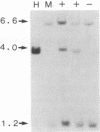Abstract
Retrovirus receptors remain a largely unexplored group of proteins. Of the receptors which allow infection of human and murine cells by various retroviruses, only three have been identified at the molecular level. These receptors include CD4 for human immunodeficiency virus, Rec-1 for murine ecotropic virus, and GLVR1 for gibbon ape leukemia virus. These three proteins show no homology to one another at the DNA or protein level. Therefore, work to date has not shown any general relationship or structural theme shared by retroviral receptors. Genes for two of these receptors (CD4 and Rec-1) and several others which have not yet been cloned have been localized to specific chromosomes. In order to assess the relationship between GLVR1 and other retroviral receptors, we mapped the chromosome location of GLVR1 in human and mouse. GLVR1 was found to map to human chromosome 2q11-q14 by in situ hybridization and somatic-cell hybrid analysis. This location is distinct from those known for receptors for retroviruses infecting human cells. Glvr-1 was then mapped in the mouse by interspecies backcrosses and found to map to chromosome 2 in a region of linkage conservation with human chromosome 2. This mouse chromosome carries Rec-2, the likely receptor for M813, a retrovirus derived from a feral Asian mouse. These data raise the interesting possibility that Rec-2 and Glvr-1 are structurally related.
Full text
PDF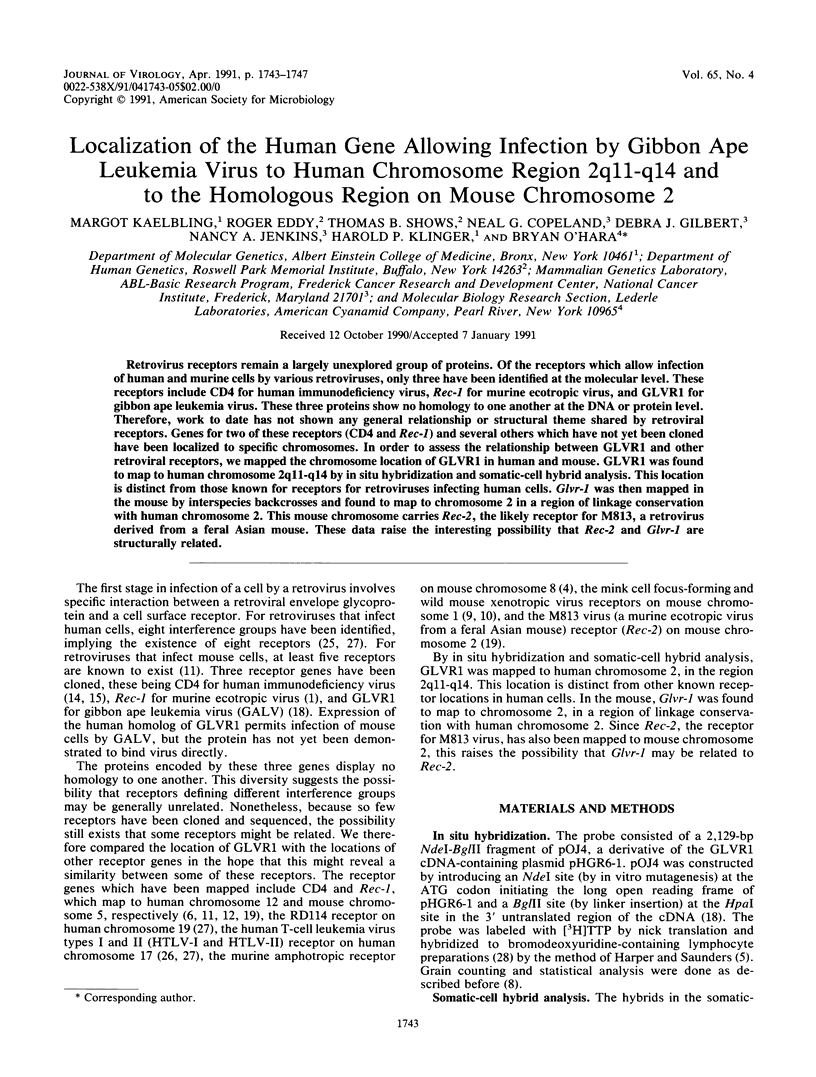
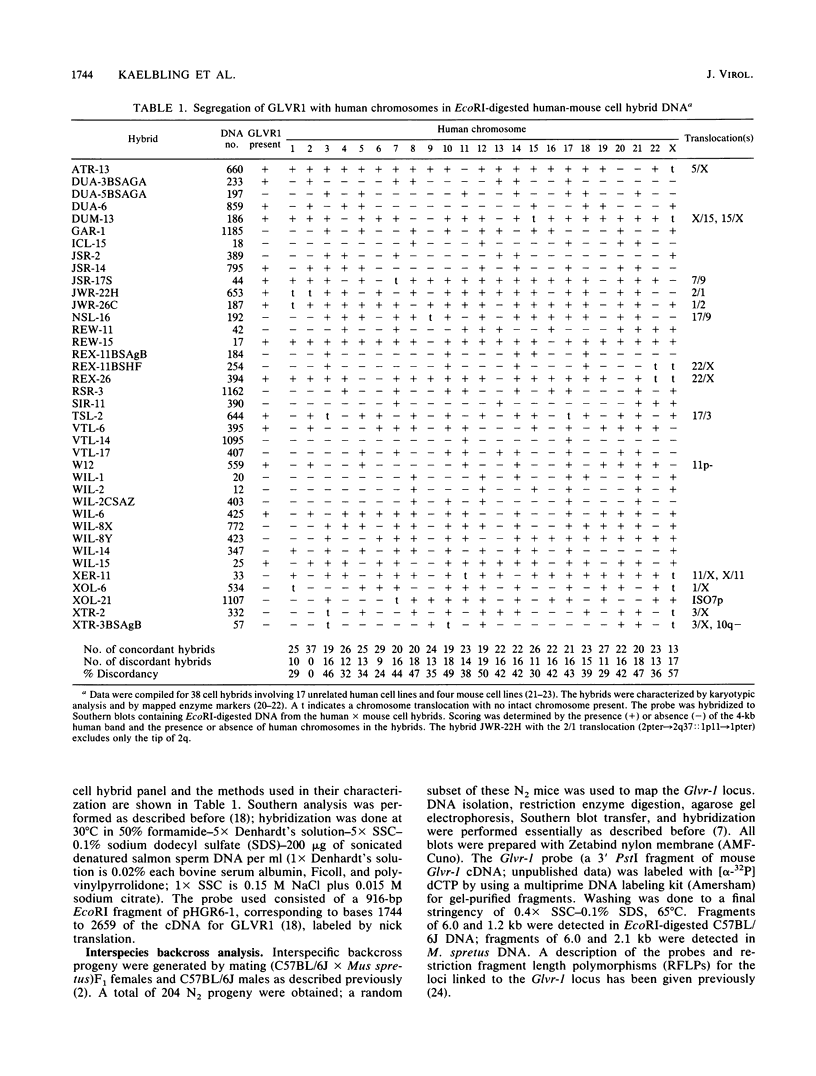
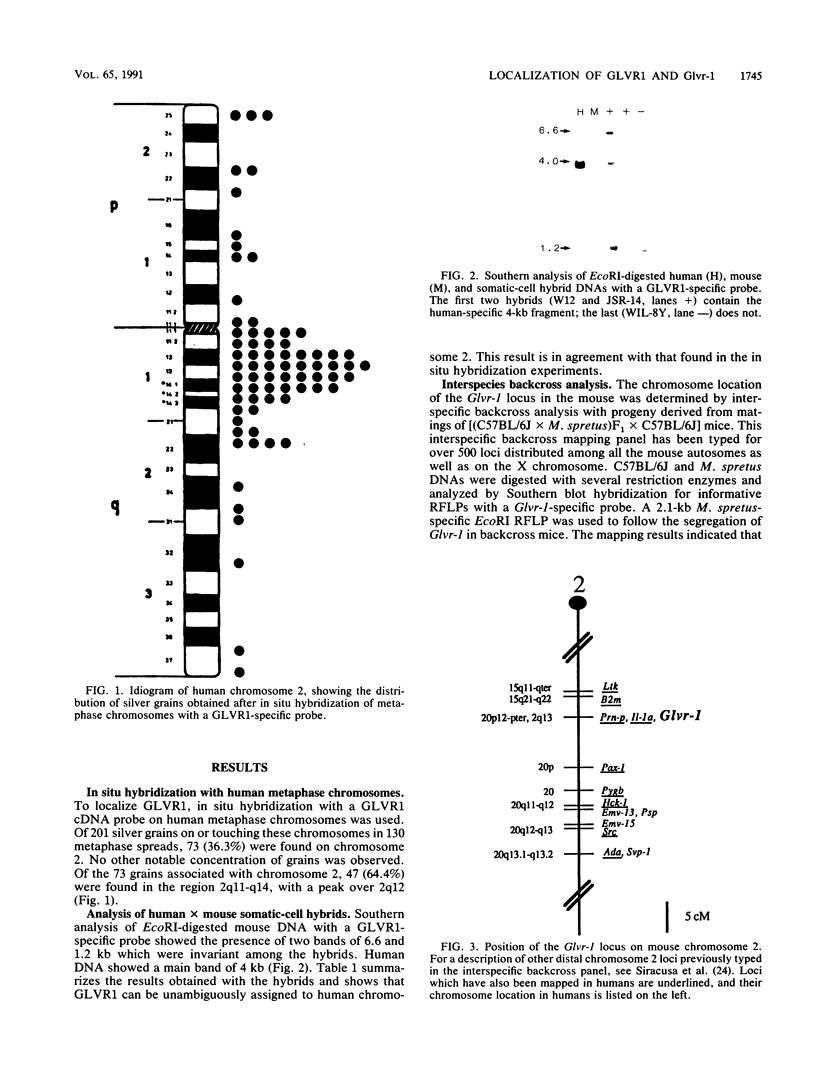
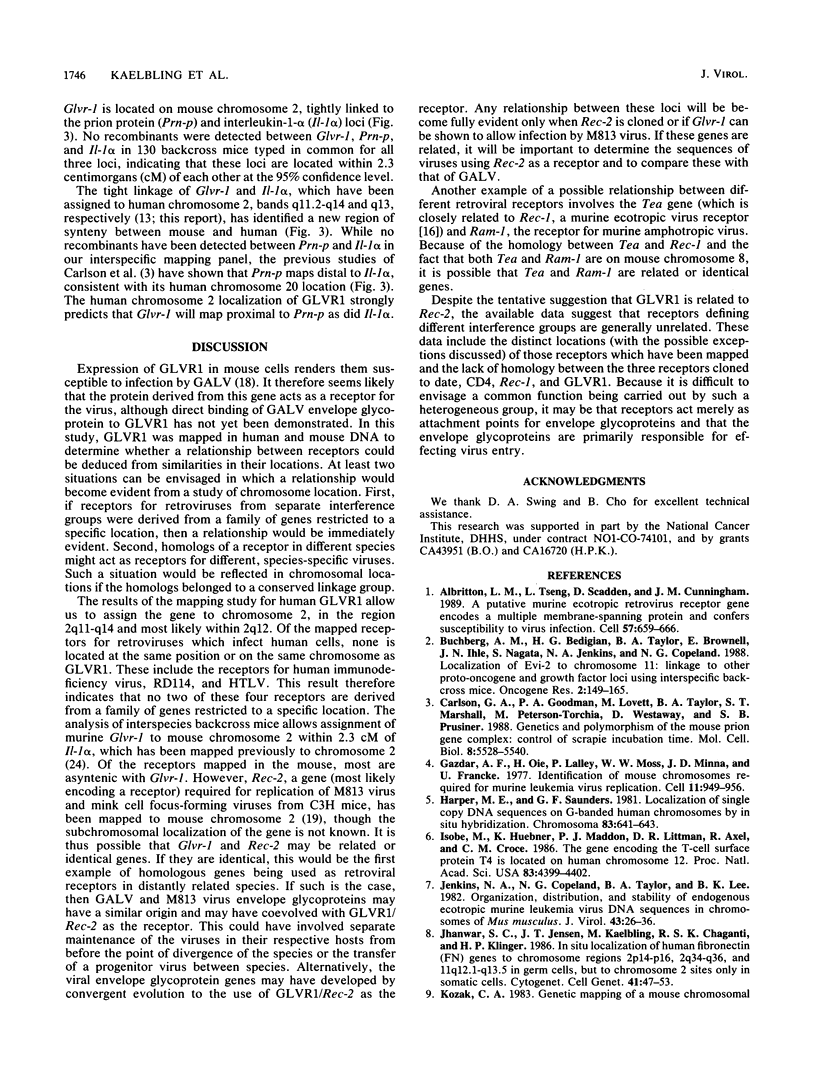
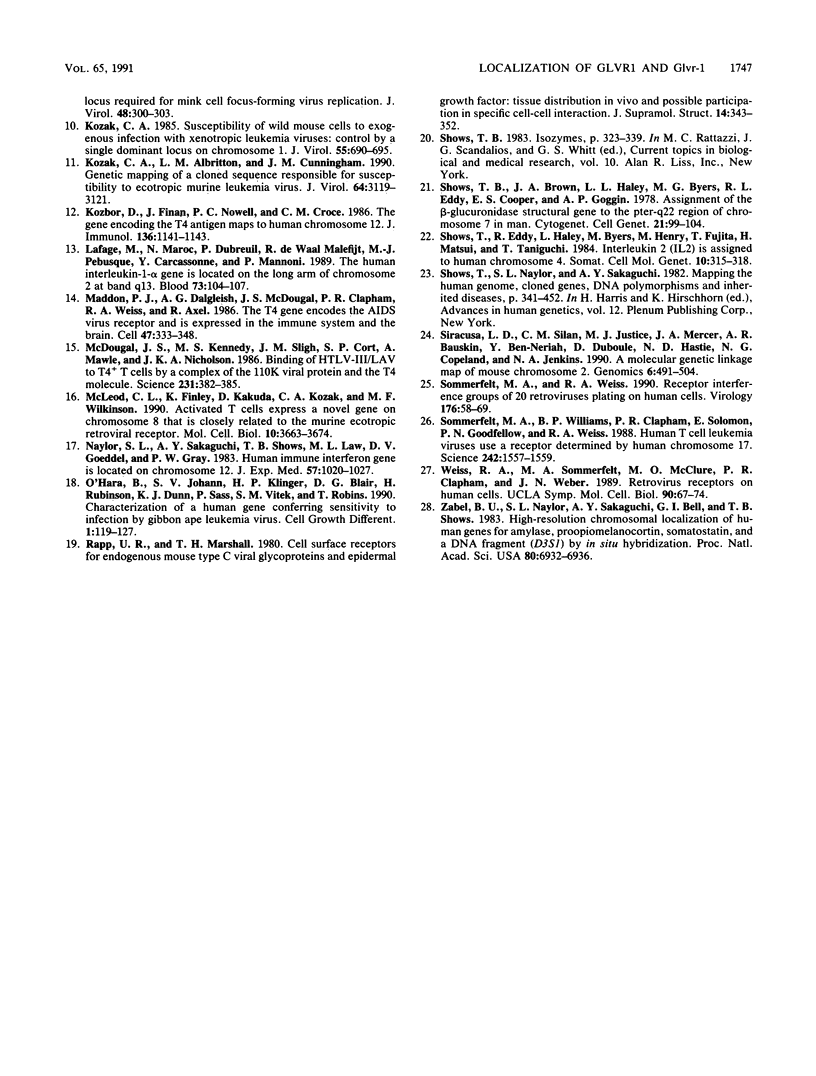
Images in this article
Selected References
These references are in PubMed. This may not be the complete list of references from this article.
- Albritton L. M., Tseng L., Scadden D., Cunningham J. M. A putative murine ecotropic retrovirus receptor gene encodes a multiple membrane-spanning protein and confers susceptibility to virus infection. Cell. 1989 May 19;57(4):659–666. doi: 10.1016/0092-8674(89)90134-7. [DOI] [PubMed] [Google Scholar]
- Buchberg A. M., Bedigian H. G., Taylor B. A., Brownell E., Ihle J. N., Nagata S., Jenkins N. A., Copeland N. G. Localization of Evi-2 to chromosome 11: linkage to other proto-oncogene and growth factor loci using interspecific backcross mice. Oncogene Res. 1988;2(2):149–165. [PubMed] [Google Scholar]
- Carlson G. A., Goodman P. A., Lovett M., Taylor B. A., Marshall S. T., Peterson-Torchia M., Westaway D., Prusiner S. B. Genetics and polymorphism of the mouse prion gene complex: control of scrapie incubation time. Mol Cell Biol. 1988 Dec;8(12):5528–5540. doi: 10.1128/mcb.8.12.5528. [DOI] [PMC free article] [PubMed] [Google Scholar]
- Gazdar A. F., Oie H., Lalley P., Moss W. W., Minna J. D. Identification of mouse chromosomes required for murine leukemia virus replication. Cell. 1977 Aug;11(4):949–956. doi: 10.1016/0092-8674(77)90306-3. [DOI] [PubMed] [Google Scholar]
- Isobe M., Huebner K., Maddon P. J., Littman D. R., Axel R., Croce C. M. The gene encoding the T-cell surface protein T4 is located on human chromosome 12. Proc Natl Acad Sci U S A. 1986 Jun;83(12):4399–4402. doi: 10.1073/pnas.83.12.4399. [DOI] [PMC free article] [PubMed] [Google Scholar]
- Jenkins N. A., Copeland N. G., Taylor B. A., Lee B. K. Organization, distribution, and stability of endogenous ecotropic murine leukemia virus DNA sequences in chromosomes of Mus musculus. J Virol. 1982 Jul;43(1):26–36. doi: 10.1128/jvi.43.1.26-36.1982. [DOI] [PMC free article] [PubMed] [Google Scholar]
- Jhanwar S. C., Jensen J. T., Kaelbling M., Chaganti R. S., Klinger H. P. In situ localization of human fibronectin (FN) genes to chromosome regions 2p14----p16, 2q34----q36, and 11q12.1----q13.5 in germ line cells, but to chromosome 2 sites only in somatic cells. Cytogenet Cell Genet. 1986;41(1):47–53. doi: 10.1159/000132195. [DOI] [PubMed] [Google Scholar]
- Kozak C. A., Albritton L. M., Cunningham J. Genetic mapping of a cloned sequence responsible for susceptibility to ecotropic murine leukemia viruses. J Virol. 1990 Jun;64(6):3119–3121. doi: 10.1128/jvi.64.6.3119-3121.1990. [DOI] [PMC free article] [PubMed] [Google Scholar]
- Kozak C. A. Genetic mapping of a mouse chromosomal locus required for mink cell focus-forming virus replication. J Virol. 1983 Oct;48(1):300–303. doi: 10.1128/jvi.48.1.300-303.1983. [DOI] [PMC free article] [PubMed] [Google Scholar]
- Kozak C. A. Susceptibility of wild mouse cells to exogenous infection with xenotropic leukemia viruses: control by a single dominant locus on chromosome 1. J Virol. 1985 Sep;55(3):690–695. doi: 10.1128/jvi.55.3.690-695.1985. [DOI] [PMC free article] [PubMed] [Google Scholar]
- Kozbor D., Finan J., Nowell P. C., Croce C. M. The gene encoding the T4 antigen maps to human chromosome 12. J Immunol. 1986 Feb 15;136(4):1141–1143. [PubMed] [Google Scholar]
- Lafage M., Maroc N., Dubreuil P., de Waal Malefijt R., Pébusque M. J., Carcassonne Y., Mannoni P. The human interleukin-1 alpha gene is located on the long arm of chromosome 2 at band q13. Blood. 1989 Jan;73(1):104–107. [PubMed] [Google Scholar]
- MacLeod C. L., Finley K., Kakuda D., Kozak C. A., Wilkinson M. F. Activated T cells express a novel gene on chromosome 8 that is closely related to the murine ecotropic retroviral receptor. Mol Cell Biol. 1990 Jul;10(7):3663–3674. doi: 10.1128/mcb.10.7.3663. [DOI] [PMC free article] [PubMed] [Google Scholar]
- Maddon P. J., Dalgleish A. G., McDougal J. S., Clapham P. R., Weiss R. A., Axel R. The T4 gene encodes the AIDS virus receptor and is expressed in the immune system and the brain. Cell. 1986 Nov 7;47(3):333–348. doi: 10.1016/0092-8674(86)90590-8. [DOI] [PubMed] [Google Scholar]
- McDougal J. S., Kennedy M. S., Sligh J. M., Cort S. P., Mawle A., Nicholson J. K. Binding of HTLV-III/LAV to T4+ T cells by a complex of the 110K viral protein and the T4 molecule. Science. 1986 Jan 24;231(4736):382–385. doi: 10.1126/science.3001934. [DOI] [PubMed] [Google Scholar]
- Naylor S. L., Sakaguchi A. Y., Shows T. B., Law M. L., Goeddel D. V., Gray P. W. Human immune interferon gene is located on chromosome 12. J Exp Med. 1983 Mar 1;157(3):1020–1027. doi: 10.1084/jem.157.3.1020. [DOI] [PMC free article] [PubMed] [Google Scholar]
- O'Hara B., Johann S. V., Klinger H. P., Blair D. G., Rubinson H., Dunn K. J., Sass P., Vitek S. M., Robins T. Characterization of a human gene conferring sensitivity to infection by gibbon ape leukemia virus. Cell Growth Differ. 1990 Mar;1(3):119–127. [PubMed] [Google Scholar]
- Rapp U. R., Marshall T. H. Cell surface receptors for endogenous mouse type C viral glycoproteins and epidermal growth factor: tissue distribution in vivo and possible participation in specific cell-cell interaction. J Supramol Struct. 1980;14(3):343–352. doi: 10.1002/jss.400140308. [DOI] [PubMed] [Google Scholar]
- Shows T. B., Brown J. A., Haley L. L., Byers M. G., Eddy R. L., Cooper E. S., Goggin A. P. Assignment of the beta-glucuronidase structural gene to the pter leads to q22 region of chromosome 7 in man. Cytogenet Cell Genet. 1978;21(1-2):99–104. doi: 10.1159/000130882. [DOI] [PubMed] [Google Scholar]
- Shows T. B. Human genome organization of enzyme loci and metabolic diseases. Isozymes Curr Top Biol Med Res. 1983;10:323–339. [PubMed] [Google Scholar]
- Shows T. B., Sakaguchi A. Y., Naylor S. L. Mapping the human genome, cloned genes, DNA polymorphisms, and inherited disease. Adv Hum Genet. 1982;12:341–452. doi: 10.1007/978-1-4615-8315-8_5. [DOI] [PubMed] [Google Scholar]
- Shows T., Eddy R., Haley L., Byers M., Henry M., Fujita T., Matsui H., Taniguchi T. Interleukin 2 (IL2) is assigned to human chromosome 4. Somat Cell Mol Genet. 1984 May;10(3):315–318. doi: 10.1007/BF01535253. [DOI] [PubMed] [Google Scholar]
- Siracusa L. D., Silan C. M., Justice M. J., Mercer J. A., Bauskin A. R., Ben-Neriah Y., Duboule D., Hastie N. D., Copeland N. G., Jenkins N. A. A molecular genetic linkage map of mouse chromosome 2. Genomics. 1990 Mar;6(3):491–504. doi: 10.1016/0888-7543(90)90479-e. [DOI] [PubMed] [Google Scholar]
- Sommerfelt M. A., Weiss R. A. Receptor interference groups of 20 retroviruses plating on human cells. Virology. 1990 May;176(1):58–69. doi: 10.1016/0042-6822(90)90230-o. [DOI] [PubMed] [Google Scholar]
- Sommerfelt M. A., Williams B. P., Clapham P. R., Solomon E., Goodfellow P. N., Weiss R. A. Human T cell leukemia viruses use a receptor determined by human chromosome 17. Science. 1988 Dec 16;242(4885):1557–1559. doi: 10.1126/science.3201246. [DOI] [PubMed] [Google Scholar]
- Zabel B. U., Naylor S. L., Sakaguchi A. Y., Bell G. I., Shows T. B. High-resolution chromosomal localization of human genes for amylase, proopiomelanocortin, somatostatin, and a DNA fragment (D3S1) by in situ hybridization. Proc Natl Acad Sci U S A. 1983 Nov;80(22):6932–6936. doi: 10.1073/pnas.80.22.6932. [DOI] [PMC free article] [PubMed] [Google Scholar]



